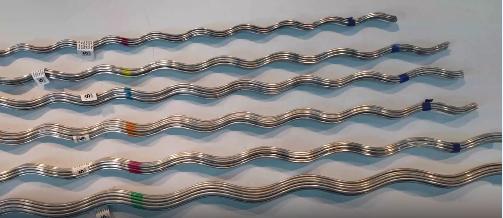Top Benefits of Using Armor Rods for Conductor Protection

Armor Rods for Conductor Protection: What Are They?
Armor rods are essential for protecting power conductors from damage caused by various mechanical and environmental stresses. Designed to wrap around conductors, armor rods serve as protective barriers that prevent wear, friction, and abrasion, ultimately prolonging conductor lifespan and reducing the likelihood of costly repairs or replacements.
Critical Benefits of Armor Rods
Armor rod for conductor protection has the following benefits:
Abrasion Resistance: Armor rods shield conductors from abrasions due to motion, wind, and vibrations, which could otherwise deteriorate the conductor's outer layer.
Increased Lifespan: By protecting against environmental elements like UV radiation, corrosion, and friction, armor rods significantly extend the life of power lines.
Vibration Damping: Conductors can suffer from aeolian vibrations caused by wind, which may lead to structural damage over time. Armor rods mitigate these vibrations, preventing excessive wear.
Enhanced Mechanical Stability: Armor rods add stability to conductors, especially in regions prone to extreme weather, by reinforcing points of tension and minimizing conductor movement.
Applications and Installation of Armor Rods
Armor rods are typically applied where conductors experience high strain levels, such as on long spans or points connecting to structures. Their design allows them to distribute load effectively across the conductor surface, decreasing localized stress. Installation is straightforward but requires precision to ensure the rods fit tightly around the conductor without compromising flexibility. Proper installation helps the rods absorb and distribute any tension or vibration across the conductor's length, enhancing system stability.
Alley Arm Brace: Strengthening Utility Poles and Power Lines
Alley arm braces are support structures that provide stability for utility poles, especially in areas where space is limited, like urban alleys. An Alley arm brace is crucial for stabilizing poles that carry heavy electrical loads and ensuring that lines are securely positioned, even under external forces like wind or mechanical strain.
Key Features of Alley Arm Braces
Enhanced Support: Alley arm braces strengthen the positioning of cross arms on poles, ensuring that conductors remain securely attached.
Space Efficiency: Ideal for tight urban spaces, alley arm braces allow utility lines to be installed in narrow areas, maximizing available space.
Load Distribution: They distribute the load evenly across the pole, reducing the risk of bending or pole failure, even when carrying multiple lines.
Resistance to External Forces: Alley arm braces prevent movement due to wind, helping the structure withstand weather-induced strain and keep conductors stable.
How Alley Arm Braces Are Installed and Used
An alley arm brace installation involves attaching it to the pole and cross-arm, providing additional support to maintain alignment. These braces are often used where multiple lines share a single pole or in locations where poles must carry heavy power loads. Their design accommodates various pole sizes, ensuring universal applicability, and the braces are typically crafted from materials resistant to weather and corrosion, adding longevity to the support structure.
Plastic Ties with Semi-Conductive Coating: Secure and Insulate
Plastic ties, often called cable or zip ties, are commonly used in utility setups to organize and secure conductor bundles. Plastic ties with semi-conductive coatings offer additional insulation benefits, making them ideal for applications where conductive materials must be bundled while remaining electrically insulated.
Applications and Proper Use of Semi-Conductive Plastic Ties
Plastic ties with semi-conductive coating are commonly used when electrical conductors must be securely bundled and stabilized. Their design reduces the chance of electrostatic discharge and minimizes damage caused by movement or friction between conductors. Installation is simple, as the ties are wrapped around conductor bundles and tightened to keep everything in place. They're instrumental in environments with high vibration levels or exposure to harsh weather conditions, offering reliability and added protection.
How These Components Contribute to Utility Infrastructure Reliability
All three components—armor rods, alley arm braces, and plastic ties with semi-conductive coatings—contribute significantly to the safety and reliability of electrical systems. Here's how they each play a role in supporting modern utility infrastructure:
Structural Integrity: Armor rods and alley arm braces work together to ensure that conductors and poles remain in place despite environmental challenges. Armor rods protect the conductors directly, while alley arm braces support the poles, creating a stable foundation for the electrical lines.
Safety Enhancement: Semi-conductive plastic ties provide an added layer of safety by securing and insulating conductor bundles, minimizing potential hazards from loose or exposed lines.
Choosing the Right Equipment for Your Utility Needs
Load Capacity: For poles carrying multiple conductors or those under high tension, durable armor rods and robust alley arm braces are crucial.
Space Constraints: In urban or densely populated areas, alley arm braces that allow for compact installations without compromising stability are essential.
Safety Requirements: Choosing semi-conductive ties helps ensure that conductor bundles are safely insulated, reducing the risk of interference and electric shock.
Advances in Materials and Technology for Utility Components
Over the years, materials used in armor rods, alley arm braces, and plastic ties have evolved significantly, enhancing their durability and performance. Many armor rods are now designed with improved coatings for greater abrasion and corrosion resistance. Similarly, alloy and galvanized steel are used in alley arm braces to blend strength and weather resistance. Semi-conductive coatings allow plastic ties to offer added insulation benefits, making them ideal for sensitive utility applications.
Comments